The global electric aircraft sensors market is valued at USD 515.1 million in 2025 and is slated to reach USD 1,143.3 million by 2035, recording an absolute increase of USD 628.2 million over the forecast period. This translates into a total growth of 122.0%, with the market forecast to expand at a compound annual growth rate (CAGR) of 8.3% between 2025 and 2035. The overall market size is expected to grow by approximately 2.22X during the same period, supported by increasing demand for electric propulsion systems, growing adoption of hybrid electric aircraft across global aviation markets, and rising preference for advanced flight control technologies across aerospace and defense applications.
The electric aircraft sensors market represents an emerging segment of the global aviation electronics industry, characterized by rapid technological advancement and accelerating demand across commercial aviation and defense channels. Market dynamics are influenced by changing aircraft electrification trends toward electric propulsion, growing interest in emission reduction management, and expanding partnerships between sensor manufacturers and aircraft companies in developed and emerging economies. Traditional hydraulic and mechanical control patterns continue evolving as manufacturers seek proven electronic alternatives that offer enhanced performance benefits and reliable monitoring characteristics.
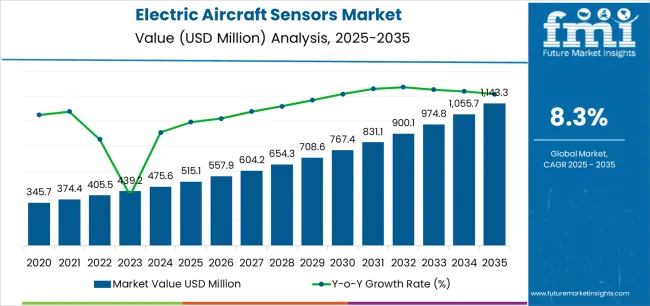
Consumer behavior in the electric aircraft sensors market reflects broader aviation trends toward electric, efficient systems that provide both operational benefits and environmental improvements. The market benefits from the growing popularity of electric aviation systems, which are recognized for their advanced technology integration and precise approach to flight management. Additionally, the versatility of electric aircraft sensors as both standalone monitoring devices and integrated system components supports sustained demand across multiple aviation applications and performance segments.
Regional adoption patterns vary significantly, with North American and European markets showing strong preference for certified sensor implementations, while Asian markets demonstrate increasing adoption of electric aviation solutions alongside conventional aircraft systems. The aviation landscape continues to evolve with sophisticated and flight-certified sensor products gaining traction in mainstream aircraft brands, reflecting manufacturer willingness to invest in proven electronic monitoring improvements and performance-oriented features.
The competitive environment features established aerospace electronics companies alongside specialized sensor technology providers that focus on unique detection capabilities and advanced monitoring methods. Manufacturing efficiency and product development optimization remain critical factors for market participants, particularly as raw material costs and certification standardization continue to fluctuate. Distribution strategies increasingly emphasize multi-channel approaches that combine traditional aerospace supply chains with direct manufacturer partnerships through specialized platforms and certification distribution agreements.
Market consolidation trends indicate that larger aerospace manufacturers are acquiring sensor technology specialists to diversify their component portfolios and access specialized monitoring processing segments. Private label development has gained momentum as aircraft companies seek to differentiate their offerings while maintaining competitive performance structures. The emergence of specialized sensor variants, including military certified and commercial grade options, reflects changing operational priorities and creates new market opportunities for innovative electronic monitoring developers. Manufacturing automation and quality control improvements enable consistent sensor production scaling while maintaining traditional accuracy characteristics that operators expect from established aerospace brands.
Between 2025 and 2030, the electric aircraft sensors market is projected to expand from USD 515.1 million to USD 767.4 million, resulting in a value increase of USD 252.3 million, which represents 40.2% of the total forecast growth for the decade. This phase of development will be shaped by increasing adoption of certified sensor systems, rising demand for flight-certified and validated solutions, and growing emphasis on electric propulsion features with enhanced monitoring characteristics. Aerospace manufacturers are expanding their electronic component capabilities to address the growing demand for specialized sensor implementations, advanced detection options, and certified offerings across aircraft segments.
| Metric | Value |
|---|---|
| Estimated Value (2025E) | USD 515.1 million |
| Forecast Value (2035F) | USD 1,143.3 million |
| Forecast CAGR (2025 to 2035) | 8.30% |
From 2030 to 2035, the market is forecast to grow from USD 767.4 million to USD 1,143.3 million, adding another USD 375.9 million, which constitutes 59.8% of the overall ten-year expansion. This period is expected to be characterized by the expansion of military grade systems, the integration of innovative detection solutions, and the development of specialized sensor implementations with enhanced accuracy profiles and extended operational capabilities. The growing adoption of flight certification will drive demand for Electric Aircraft Sensors with superior performance characteristics and compatibility with advanced aircraft manufacturing technologies across aerospace production operations.
Between 2020 and 2025, the electric aircraft sensors market experienced rapid growth, driven by increasing demand for electric propulsion systems and growing recognition of electronic sensors as essential components for modern aviation programs across commercial aircraft and defense applications. The market developed as aircraft manufacturers recognized the potential for sensor solutions to provide both monitoring benefits and performance advantages while enabling convenient integration protocols. Technological advancement in detection techniques and military-grade development began emphasizing the critical importance of maintaining sensor accuracy and reliability in diverse aircraft environments.
Market expansion is being supported by the increasing global demand for electric propulsion systems and the corresponding need for electronic sensors that can provide superior monitoring benefits and performance advantages while enabling enhanced aviation outcomes and extended compatibility across various aerospace and defense applications. Modern aircraft and aviation industry specialists are increasingly focused on implementing proven electronic sensors that can deliver effective flight monitoring, minimize mechanical system dependency, and provide consistent performance throughout complex aircraft configurations and diverse operational environments. Electric Aircraft Sensors proven ability to deliver exceptional monitoring efficacy against mechanical alternatives, enable advanced aircraft integration, and support modern aviation protocols makes it an essential component for contemporary aerospace manufacturing and commercial aviation operations.
The growing emphasis on electric propulsion and electronic system adoption is driving demand for Electric Aircraft Sensors that can support large-scale manufacturing requirements, improve operational outcomes, and enable advanced monitoring systems. Aircraft preference for products that combine effective flight monitoring with proven reliability and performance benefits is creating opportunities for innovative sensor implementations. The rising influence of aviation electrification trends and environmental awareness is also contributing to increased demand for Electric Aircraft Sensors that can provide advanced accuracy, seamless aircraft integration, and reliable performance across extended operational periods.
The electric aircraft sensors market is poised for rapid growth and technological advancement. As aircraft manufacturers across North America, Europe, Asia-Pacific, and emerging markets seek components that deliver exceptional monitoring quality, advanced accuracy capabilities, and reliable performance options, Electric Aircraft Sensors solutions are gaining prominence not just as electronic devices but as strategic enablers of aviation technologies and advanced aerospace functionality.
Rising electric aircraft adoption in Asia-Pacific and expanding electrification initiatives globally amplify demand, while manufacturers are leveraging innovations in sensor engineering, advanced detection integration, and performance management technologies.
Pathways like military-grade implementations, flight certified platforms, and specialized monitoring solutions promise strong margin uplift, especially in premium aircraft segments. Geographic expansion and product diversification will capture volume, particularly where local aviation preferences and advanced performance adoption are critical. Regulatory support around flight certification, monitoring efficacy standards, and safety protocols give structural support.
The market is segmented by type, application, technology, end-user, certification level, distribution channel, and region. By type, the market is divided into pressure sensors, temperature sensors, force sensors, torque sensors, speed sensors, and others categories. By application, it covers electric aircraft, hybrid electric aircraft, and conventional aircraft with electric systems segments. By technology, the market includes MEMS technology, fiber optic technology, and piezoelectric technology. By end-user, it comprises aircraft manufacturers, mro services, airlines, and defense organizations. By certification level, the market is categorized into military grade, commercial aviation grade, and general aviation grade categories. By distribution channel, it includes direct sales, authorized distributors, and online platforms. Regionally, the market is divided into North America, Europe, East Asia, South Asia & Pacific, Latin America, and the Middle East & Africa.
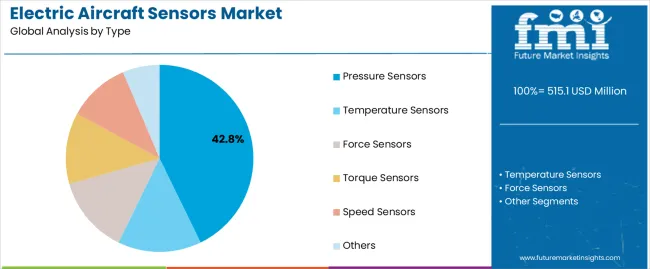
The pressure sensors segment is projected to account for 42.8% of the electric aircraft sensors market in 2025, reaffirming its position as the leading type category. Aircraft manufacturers and aviation system integrators increasingly utilize Pressure Sensor implementations for their superior monitoring standards when operating across diverse aircraft platforms, excellent operational compliance properties, and widespread acceptance in applications ranging from basic flight systems to premium aviation operations. Pressure sensor technology's certified monitoring methods and proven accuracy capabilities directly address the manufacturer requirements for compliant sensing solutions in complex aircraft environments.
This type segment forms the foundation of modern electric aircraft adoption patterns, as it represents the implementation with the greatest operational acceptance and established market demand across multiple aircraft categories and aviation segments. Manufacturer investments in pressure sensor certification and accuracy consistency continue to strengthen adoption among aircraft producers and aviation companies. With operators prioritizing safety and operational compliance, Pressure Sensor implementations align with both functionality preferences and performance expectations, making them the central component of comprehensive flight monitoring strategies.
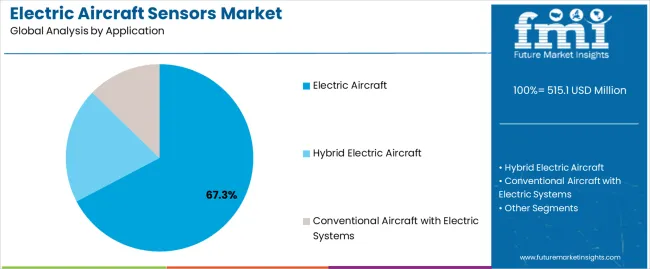
Electric Aircraft applications are projected to represent 67.3% of Electric Aircraft Sensors demand in 2025, underscoring their critical role as the primary integration channel for sensor technologies across aircraft manufacturing, product development, and aviation operations. Aircraft manufacturers prefer Electric Aircraft Sensors for their exceptional monitoring characteristics, scalable integration options, and ability to enhance aircraft performance while ensuring consistent sensor functionality throughout diverse aviation platforms and manufacturing processes. Positioned as essential monitoring components for modern aircraft production, Electric Aircraft Sensors solutions offer both operational advantages and manufacturing efficiency benefits.
The segment is supported by continuous innovation in aerospace technologies and the growing availability of specialized implementations that enable diverse aircraft requirements with enhanced monitoring uniformity and extended reliability capabilities. Additionally, aircraft manufacturers are investing in advanced sensors to support large-scale production integration and product development. As electric aviation trends become more prevalent and environmental awareness increases, Electric Aircraft applications will continue to represent a major implementation market while supporting advanced aerospace utilization and sensor integration strategies.
The electric aircraft sensors market is advancing rapidly due to increasing demand for electric propulsion systems and growing adoption of electronic sensors that provide superior monitoring characteristics and performance benefits while enabling enhanced aviation outcomes across diverse aerospace and defense applications. The market faces challenges, including complex certification requirements, evolving aviation standards, and the need for specialized aerospace expertise and quality programs. Innovation in sensor engineering and advanced detection systems continues to influence product development and market expansion patterns.
The growing adoption of electric propulsion, advanced flight management capabilities, and aviation electrification awareness is enabling sensor developers to produce advanced Electric Aircraft Sensors solutions with superior monitoring positioning, enhanced accuracy profiles, and seamless integration functionalities. Advanced electronic detection systems provide improved aviation outcomes while allowing more efficient manufacturing workflows and reliable performance across various aircraft applications and operational conditions. Developers are increasingly recognizing the competitive advantages of electronic system integration capabilities for market differentiation and monitoring positioning.
Modern Electric Aircraft Sensors providers are incorporating advanced detection technology, performance control integration, and sophisticated monitoring solutions to enhance product appeal, enable intelligent monitoring features, and deliver value-added solutions to aircraft customers. These technologies improve detection efficiency while enabling new market opportunities, including certified accuracy, optimized reliability, and enhanced durability characteristics. Advanced performance integration also allows developers to support comprehensive aerospace sensor technologies and market expansion beyond traditional mechanical approaches.
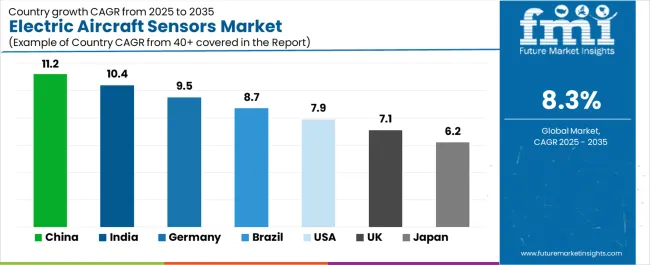
| Country | CAGR (2025-2035) |
|---|---|
| China | 11.2% |
| India | 10.4% |
| Germany | 9.5% |
| Brazil | 8.7% |
| USA | 7.9% |
| UK | 7.1% |
| Japan | 6.2% |
The electric aircraft sensors market is experiencing robust growth globally, with China leading at an 11.2% CAGR through 2035, driven by expanding electric aviation manufacturing capacity, growing aircraft modernization programs, and significant investment in aerospace sensor development. India follows at 10.4%, supported by increasing aerospace production expansion, growing aviation technology integration patterns, and expanding modern aircraft infrastructure. Germany shows growth at 9.5%, emphasizing aerospace engineering leadership and sensor technology development. Brazil records 8.7%, focusing on expanding aviation manufacturing capabilities and aerospace sensor integration modernization. The USA demonstrates 7.9% growth, prioritizing advanced aircraft technology development and electric aviation adoption trends. The UK exhibits 7.1% growth, emphasizing aviation technology innovation and premium sensor development. Japan shows 6.2% growth, supported by aerospace excellence initiatives and precision-focused production patterns.
The report covers an in-depth analysis of 40+ countries top-performing countries are highlighted below.
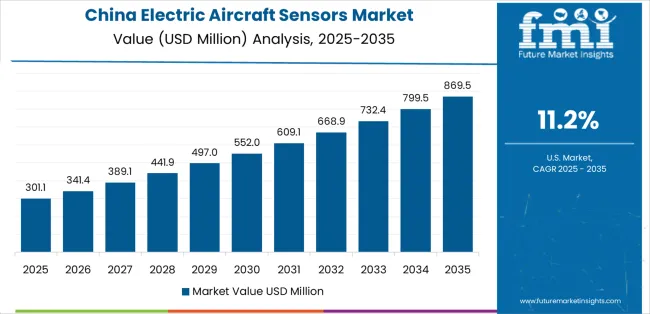
Revenue from Electric Aircraft Sensors in China is projected to exhibit robust growth with a CAGR of 11.2% through 2035, driven by expanding electric aviation manufacturing capacity and rapidly growing aerospace sensor integration supported by government initiatives promoting aviation technology development. The country's strong position in electronics production and increasing investment in aircraft manufacturing infrastructure are creating substantial demand for advanced sensor implementations. Major aerospace manufacturers and technology companies are establishing comprehensive production capabilities to serve both domestic aircraft demand and expanding export markets.
Revenue from Electric Aircraft Sensors in India is expanding at a CAGR of 10.4%, supported by the country's growing aerospace manufacturing sector, expanding aviation technology capacity, and increasing adoption of advanced sensor technologies. The country's initiatives promoting aviation modernization and growing technology awareness are driving requirements for performance-controlled sensor systems. International aircraft providers and domestic aerospace companies are establishing extensive production and manufacturing capabilities to address the growing demand for modern aviation solutions.
Revenue from Electric Aircraft Sensors in Germany is expanding at a CAGR of 9.5%, supported by the country's aerospace engineering heritage, strong emphasis on precision sensor technology, and robust demand for advanced electronic components in premium and military applications. The nation's mature aircraft sector and technology-focused operations are driving sophisticated sensor implementations throughout the aviation industry. Leading manufacturers and aerospace specialists are investing extensively in precision development and advanced monitoring technologies to serve both domestic and international markets.
Revenue from Electric Aircraft Sensors in Brazil is growing at a CAGR of 8.7%, driven by the country's expanding aviation manufacturing sector, growing aerospace sensor integration programs, and increasing investment in aircraft technology development. Brazil's large aerospace market and commitment to manufacturing advancement are supporting demand for diverse sensor solutions across multiple aircraft segments. Manufacturers are establishing comprehensive production capabilities to serve the growing domestic market and expanding aviation opportunities.
Revenue from Electric Aircraft Sensors in the USA is expanding at a CAGR of 7.9%, supported by the country's advanced aerospace technology sector, strategic focus on electric aviation solutions, and established aircraft manufacturing capabilities. The USA's aviation innovation leadership and precision technology integration are driving demand for specialized sensor implementations in premium aircraft, defense applications, and advanced aviation products. Manufacturers are investing in comprehensive component development to serve both domestic specialty markets and international precision applications.
Revenue from Electric Aircraft Sensors in the UK is growing at a CAGR of 7.1%, driven by the country's focus on aviation technology advancement, emphasis on premium sensor innovation, and strong position in aerospace monitoring development. The UK's established aircraft innovation capabilities and commitment to technology diversification are supporting investment in specialized sensor technologies throughout major aviation regions. Industry leaders are establishing comprehensive technology integration systems to serve domestic premium aircraft production and defense aviation applications.
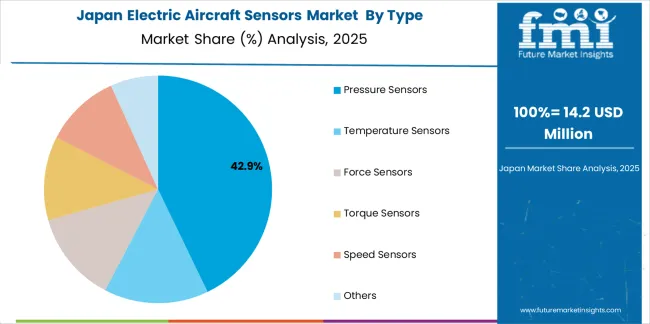
Revenue from Electric Aircraft Sensors in Japan is expanding at a CAGR of 6.2%, supported by the country's aviation excellence initiatives, growing precision technology sector, and strategic emphasis on advanced aircraft development. Japan's advanced quality control capabilities and integrated aviation systems are driving demand for high-precision sensor platforms in premium aircraft, defense aviation, and advanced technology applications. Leading manufacturers are investing in specialized capabilities to serve the stringent requirements of technology-focused aviation and precision aircraft industries.
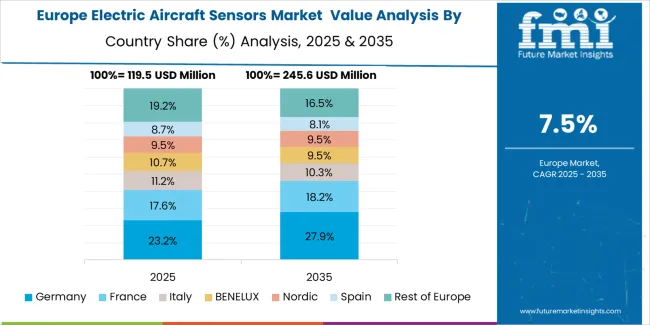
The electric aircraft sensors market in Europe is projected to grow from USD 192.2 million in 2025 to USD 345.7 million by 2035, registering a CAGR of 6.1% over the forecast period. Germany is expected to maintain its leadership position with a 41.3% market share in 2025, declining slightly to 40.8% by 2035, supported by its strong aerospace engineering culture, sophisticated sensor manufacturing capabilities, and comprehensive aviation industry serving diverse Electric Aircraft Sensors applications across Europe.
France follows with a 24.7% share in 2025, projected to reach 25.2% by 2035, driven by robust demand for premium sensor technologies in defense aviation applications, advanced aerospace programs, and electric aircraft markets, combined with established aviation infrastructure and technology integration expertise. The United Kingdom holds a 18.9% share in 2025, expected to reach 19.4% by 2035, supported by strong aviation technology sector and growing premium sensor activities. Italy commands a 9.8% share in 2025, projected to reach 10.3% by 2035, while Spain accounts for 3.7% in 2025, expected to reach 3.9% by 2035. The Netherlands maintains a 1.4% share in 2025, growing to 1.6% by 2035. The Rest of Europe region, including Nordic countries, Eastern Europe, Belgium, Poland, and other nations, is anticipated to maintain momentum, with its collective share moving from 0.2% to -1.2% by 2035, attributed to increasing aviation modernization in Eastern Europe and growing technology penetration in Nordic countries implementing advanced aircraft programs.
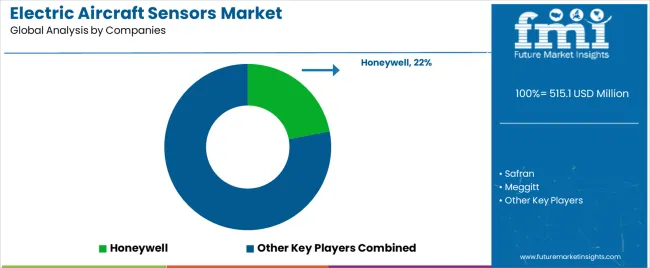
The electric aircraft sensors market is characterized by competition among established aerospace electronics companies, specialized sensor technology developers, and integrated aviation solution providers. Companies are investing in sensor technology research, monitoring optimization, advanced detection system development, and comprehensive electronic portfolios to deliver consistent, high-quality, and application-specific Electric Aircraft Sensors solutions. Innovation in advanced detection integration, accuracy enhancement, and aircraft compatibility improvement is central to strengthening market position and competitive advantage.
Honeywell leads the market with 22% share, offering comprehensive aerospace sensor solutions including precision detection platforms and advanced monitoring systems with a focus on premium and defense aircraft applications. Safran provides specialized aerospace capabilities with an emphasis on advanced sensor implementations and innovative aviation solutions. Meggitt delivers comprehensive aircraft sensor services with a focus on integrated platforms and large-scale aviation applications. TE Connectivity specializes in advanced electronic sensors and specialized implementations for aerospace applications. AMETEK focuses on premium aviation integration and innovative technology solutions. Lockheed Martin offers advanced aerospace sensor platforms with emphasis on defense-critical and high-precision applications.
| Item | Value |
|---|---|
| Quantitative Units | USD 515.1 million |
| Type | Pressure Sensors; Temperature Sensors; Force Sensors; Torque Sensors; Speed Sensors; Others |
| Application | Electric Aircraft; Hybrid Electric Aircraft; Conventional Aircraft with Electric Systems |
| Technology | MEMS Technology; Fiber Optic Technology; Piezoelectric Technology |
| End-User | Aircraft Manufacturers; MRO Services; Airlines; Defense Organizations |
| Certification Level | Military Grade; Commercial Aviation Grade; General Aviation Grade |
| Distribution Channels | Direct Sales; Authorized Distributors; Online Platforms |
| Regions Covered | North America; Europe; East Asia; South Asia & Pacific; Latin America; Middle East & Africa |
| Countries Covered | China; India; Germany; Brazil; United States; United Kingdom; Japan; and 40+ additional countries |
| Key Companies Profiled | Honeywell; Safran; Meggitt; TE Connectivity; AMETEK; Lockheed Martin |
| Additional Attributes | Dollar sales by type and application category; regional demand trends; competitive landscape; technological advancements in sensor engineering; advanced monitoring development; precision innovation; aircraft integration protocols |
The global electric aircraft sensors market is estimated to be valued at USD 515.1 million in 2025.
The market size for the electric aircraft sensors market is projected to reach USD 1,143.3 million by 2035.
The electric aircraft sensors market is expected to grow at a 8.3% CAGR between 2025 and 2035.
The key product types in electric aircraft sensors market are pressure sensors, temperature sensors, force sensors, torque sensors, speed sensors and others.
In terms of application, electric aircraft segment to command 67.3% share in the electric aircraft sensors market in 2025.






Full Research Suite comprises of:
Market outlook & trends analysis
Interviews & case studies
Strategic recommendations
Vendor profiles & capabilities analysis
5-year forecasts
8 regions and 60+ country-level data splits
Market segment data splits
12 months of continuous data updates
DELIVERED AS:
PDF EXCEL ONLINE
Electric Traction Motor Market Forecast Outlook 2025 to 2035
Electric Vehicle Sensor Market Forecast and Outlook 2025 to 2035
Electric Vehicle Motor Market Forecast and Outlook 2025 to 2035
Electric Off-Road ATVs & UTVs Market Size and Share Forecast Outlook 2025 to 2035
Electric Blind Rivet Gun Market Size and Share Forecast Outlook 2025 to 2035
Electric Fireplace Market Size and Share Forecast Outlook 2025 to 2035
Electric Glider Market Size and Share Forecast Outlook 2025 to 2035
Electric Vehicle Battery Conditioners Market Size and Share Forecast Outlook 2025 to 2035
Electric Power Steering Motors Market Size and Share Forecast Outlook 2025 to 2035
Electric Motor Market Size and Share Forecast Outlook 2025 to 2035
Electric Gripper Market Size and Share Forecast Outlook 2025 to 2035
Electric Boat Market Size and Share Forecast Outlook 2025 to 2035
Electric Bicycle Market Size and Share Forecast Outlook 2025 to 2035
Electric Vehicle Transmission Market Size and Share Forecast Outlook 2025 to 2035
Electrical Enclosure Market Size and Share Forecast Outlook 2025 to 2035
Electrical Sub Panels Market Size and Share Forecast Outlook 2025 to 2035
Electric Cargo Bike Market Size and Share Forecast Outlook 2025 to 2035
Electrical Testing Services Market Size and Share Forecast Outlook 2025 to 2035
Electric Sub-meter Market Size and Share Forecast Outlook 2025 to 2035
Electric Light Commercial Vehicle Market Size and Share Forecast Outlook 2025 to 2035

Thank you!
You will receive an email from our Business Development Manager. Please be sure to check your SPAM/JUNK folder too.
Chat With
MaRIA